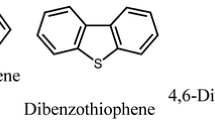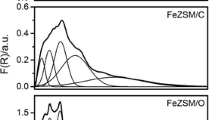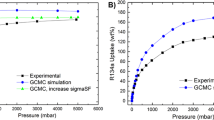Abstract
Metal–organic frameworks (MOFs) are the promising functional materials for adsorption in liquid phase. It is important to understand the details of chemical bonding between the aromatic and heteroaromatic adsorbates and major structural units in the MOF sorbent—metal coordinatively unsaturated sites (CUS) and organic linkers. In this paper, we report the mechanistic studies of adsorption of naphthalene and indole on F300 Basolite MOF by two complementary spectroscopic methods and density functional theory (DFT) calculations. Fluorescence spectra, the near-UV/visible diffuse reflectance spectroscopy (near-UV/VIS DRS) and DFT calculations suggest that naphthalene forms an adsorption complex with F300 MOF where naphthalene is quantum confined within the cavity of the F300, weakly electronically bound to the Fe(III) CUS, and strongly dispersively stabilized by side interactions with the benzene rings of the linker of F300. On the other hand, indole forms an adsorption complex with F300 MOF in which indole is electronically bound to the Fe(III) CUS and dispersively stabilized by the side interactions with benzene rings of the linker. Coordination bonds between indole and F300 MOF in the adsorption complex are detected by geometry optimization using the DFT method, and electronic spectra are calculated by the time-dependent-DFT method. The direct spectroscopic proof of the formation of adsorption complex with coordination bonds between indole and F300 MOF is provided by the complementary near-UV/VIS DRS spectroscopy (new absorption bands at 460–660 nm), the wavelength-dependent fluorescence spectroscopy (new fluorescence bands at 410 and 430 nm) and by the time-dependent fluorescence spectroscopy.










Similar content being viewed by others
References
D. Singh, A. Chopra, M.B. Patel, A.S. Sarpal, A comparative evaluation of nitrogen compounds in petroleum distillates. Chromatographia 74(1–2), 121–126 (2011)
A. Samokhvalov, E.C. Duin, S. Nair, M. Bowman, Z. Davis, B.J. Tatarchuk, Study of the surface chemical reactions of thiophene with Ag/titania by the complementary temperature-programmed electron spin resonance, temperature-programmed desorption, and X-ray photoelectron spectroscopy: adsorption, desorption, and sorbent regeneration mechanisms. J. Phys. Chem. C 114, 4075–4085 (2010)
A. Jayaraman, G.O. Alptekin, M. Dubovik, M. Schaefer, J. Monroe, K. Bradley, FUEL 212-desulfurization of liquid fuels by adsorption. Abstracts of papers of the American Chemical Society, 2008, p. 235
M. Almarri, X. Ma, C. Song, Role of surface oxygen-containing functional groups in liquid-phase adsorption of nitrogen compounds on carbon-based adsorbents. Energy Fuels 23, 3940–3947 (2009)
E.S. Huh, A. Zazybin, J. Palgunadi, S. Ahn, J. Hong, H.S. Kim, M. Cheong, B.S. Ahn, Zn-containing ionic liquids for the extractive denitrogenation of a model oil: a mechanistic consideration. Energy Fuels 23(6), 3032–3038 (2009)
D. Saha, S.G. Deng, Z.G. Yang, Hydrogen adsorption on metal-organic framework (MOF-5) synthesized by DMF approach. J. Porous Mater. 16(2), 141–149 (2009)
S.-C. Xiang, Z. Zhang, C.-G. Zhao, K. Hong, X. Zhao, D.-R. Ding, M.-H. Xie, C.-D. Wu, M.C. Das, R. Gill, K.M. Thomas, B. Chen, Rationally tuned micropores within enantiopure metal-organic frameworks for highly selective separation of acetylene and ethylene. Nat. Commun. 2, 204 (2011)
S. Keskin, T.M. van Heest, D.S. Sholl, Can metal-organic framework materials play a useful role in large-scale carbon dioxide separations? ChemSusChem 3(8), 879–891 (2010)
I. Bezverkhyy, G. Ortiz, G. Chaplais, C. Marichal, G. Weber, J.P. Bellat, MIL-53(Al) under reflux in water: formation of gamma-AlO(OH) shell and H2BDC molecules intercalated into the pores. Microporous Mesoporous Mater. 183, 156–161 (2014)
P. Horcajada, S. Surble, C. Serre, D.Y. Hong, Y.K. Seo, J.S. Chang, J.M. Greneche, I. Margiolaki, G. Ferey, Synthesis and catalytic properties of MIL-100(Fe), an iron(III) carboxylate with large pores. Chem. Commun. 27, 2820–2822 (2007)
A. Dhakshinamoorthy, M. Alvaro, P. Horcajada, E. Gibson, M. Vishnuvarthan, A. Vimont, J.-M. Grenèche, C. Serre, M. Daturi, H. Garcia, Comparison of porous iron trimesates basolite F300 and MIL-100(Fe) as heterogeneous catalysts for lewis acid and oxidation reactions: roles of structural defects and stability. ACS Catal. 2(10), 2060–2065 (2012)
M. Maes, M. Trekels, M. Boulhout, S. Schouteden, F. Vermoortele, L. Alaerts, D. Heurtaux, Y.-K. Seo, Y.K. Hwang, J.-S. Chang, I. Beurroies, R. Denoyel, K. Temst, A. Vantomme, P. Horcajada, C. Serre, D.E. De Vos, Selective removal of N-heterocyclic aromatic contaminants from fuels by Lewis acidic metal-organic frameworks. Angew. Chem. Int. Ed. 50(18), 4210–4214 (2011)
A. Samokhvalov, B.J. Tatarchuk, Review of experimental characterization of active sites and determination of molecular mechanisms of adsorption, desorption and regeneration of the deep and ultradeep desulfurization sorbents for liquid fuels. Catal. Rev. 52, 381–410 (2010)
G. Shan, H. Liu, J. Xing, G. Zhang, K. Wang, Separation of polycyclic aromatic compounds from model gasoline by magnetic alumina sorbent based on pi-complexation. Ind. Eng. Chem. Res. 43(3), 758–761 (2004)
A. Centrone, E.E. Santiso, T.A. Hatton, Separation of chemical reaction intermediates by metal-organic frameworks. Small 7(16), 2356–2364 (2011)
T.M. Nicholson, S.K. Bhatia, Electrostatically mediated specific adsorption of small molecules in metallo-organic frameworks. J. Phys. Chem. B 110(49), 24834–24836 (2006)
M. Tong, D. Liu, Q. Yang, S. Devautour-Vinot, G. Maurin, C. Zhong, Influence of framework metal ions on the dye capture behavior of MIL-100 (Fe, Cr) MOF type solids. J. Mater. Chem. A 1(30), 8534–8537 (2013)
A. Samokhvalov, S. Nair, E.C. Duin, B.J. Tatarchuk, Surface characterization of Ag/titania adsorbents. Appl. Surf. Sci. 256, 3647–3652 (2010)
A. Samokhvalov, E.C. Duin, S. Nair, B.J. Tatarchuk, An in situ temperature-programmed XPS study of the surface chemical reactions of thiophene with Ag/titania. Surf. Interface Anal. 42(9), 1476–1482 (2010)
A. Samokhvalov, E.C. Duin, S. Nair, B.J. Tatarchuk, Adsorption and desorption of dibenzothiophene on Ag–titania studied by the complementary temperature-programmed XPS and ESR. Appl. Surf. Sci. 257(8), 3226–3232 (2010)
P. Dhage, A. Samokhvalov, M.L. McKee, E.C. Duin, B.J. Tatarchuk, Reactive adsorption of hydrogen sulfide by promoted sorbents Cu–ZnO/SiO2: active sites by experiment and simulation. Surf. Interface Anal. 45(5), 865–872 (2013)
G. Blanco-Brieva, J.M. Campos-Martin, S.M. Al-Zahrani, J.L.G. Fierro, Effectiveness of metal-organic frameworks for removal of refractory organo-sulfur compound present in liquid fuels. Fuel 90(1), 190–197 (2011)
J.R. Lakowicz, Principles of Fluorescence Spectroscopy (Springer, New York, 2006)
Gaussian 09, Revision D.01, M.J. Frisch, G.W. Trucks, H.B. Schlegel, G.E. Scuseria, M.A. Robb, J.R. Cheeseman, G. Scalmani, V. Barone, B. Mennucci, G.A. Petersson, H. Nakatsuji, M. Caricato, X. Li, H.P. Hratchian, A.F. Izmaylov, J. Bloino, G. Zheng, J.L. Sonnenberg, M. Hada, M. Ehara, K. Toyota, R. Fukuda, J. Hasegawa, M. Ishida, T. Nakajima, Y. Honda, O. Kitao, H. Nakai, T. Vreven, J.A. Montgomery, Jr., J.E. Peralta, F. Ogliaro, M. Bearpark, J.J. Heyd, E. Brothers, K.N. Kudin, V.N. Staroverov, R. Kobayashi, J. Normand, K. Raghavachari, A. Rendell, J.C. Burant, S.S. Iyengar, J. Tomasi, M. Cossi, N. Rega, J.M. Millam, M. Klene, J.E. Knox, J.B. Cross, V. Bakken, C. Adamo, J. Jaramillo, R. Gomperts, R.E. Stratmann, O. Yazyev, A.J. Austin, R. Cammi, C. Pomelli, J.W. Ochterski, R.L. Martin, K. Morokuma, V.G. Zakrzewski, G.A. Voth, P. Salvador, J.J. Dannenberg, S. Dapprich, A.D. Daniels, Ö. Farkas, J.B. Foresman, J.V. Ortiz, J. Cioslowski, D.J. Fox (Gaussian Inc., Wallingford, 2009)
W. Koch, M.C. Holthausen, A Chemist’s Guide to Density Functional Theory, 2nd edn. (Wiley-VCH, Weinheim, 2001)
C.J. Cramer, Essentials of Computational Chemistry: Theories and Models (Wiley, Chichester, 2004)
P.J. Hay, W.R. Wadt, Ab initio effective core potentials for molecular calculations. Potentials for the transition metal atoms Sc to Hg. J. Chem. Phys. 82(1), 270–283 (1985)
W.R. Wadt, P.J. Hay, Ab initio effective core potentials for molecular calculations. Potentials for main group elements Na to Bi. J. Chem. Phys. 82(1), 284–298 (1985)
P.J. Hay, W.R. Wadt, Ab initio effective core potentials for molecular calculations. Potentials for K to Au including the outermost core orbitals. J. Chem. Phys. 82(1), 299–310 (1985)
M. Dolg, U. Wedig, H. Stoll, H. Preuss, Energy-adjusted abinitio pseudopotentials for the first row transition elements. J. Chem. Phys. 86(2), 866–872 (1987)
S. Grimme, J. Antony, S. Ehrlich, H. Krieg, A consistent and accurate ab initio parametrization of density functional dispersion correction (DFT-D) for the 94 elements H-Pu. J. Chem. Phys. 132(15) (2010)
A.I. Privalova, J.P. Morozova, E.R. Kashapova, V.J. Artyukhov, Spectral and luminescent properties of 1-substituted naphthalenes. J. Appl. Spectrosc. 78(3), 309–317 (2011)
O. Schnepp, D.S. McClure, A vibrational analysis of the fluorescence of naphthalene vapor. J. Chem. Phys. 20(9), 1375–1383 (1952)
R.M. Hochstrasser, The luminescence of organic molecular crystals. Rev. Mod. Phys. 34(3), 531–550 (1962)
I.B. Berlman, Handbook of Fluorescence Spectra of Aromatic Molecules (Academic Press, NY, 1971), p. 258
Z.Z. Zhang, J.L. Long, X.Q. Xie, H. Lin, Y.E. Zhou, R.S. Yuan, W.X. Dai, Z.X. Ding, X.X. Wang, X.Z. Fu, Probing the electronic structure and photoactivation process of nitrogen-doped TiO2 using DRS, PL, and EPR. ChemPhysChem 13(6), 1542–1550 (2012)
F.J. Smith, A.T. Armstrong, S.P. McGlynn, Energy of excimer luminescence. V. Excimer fluorescence of naphthalene and methylnaphthalenes. J. Chem. Phys. 44(2), 442–448 (1966)
J.B. Aladekomo, J.B. Birks, ‘Excimer’ fluorescence. VII. Spectral studies of naphthalene and its derivatives. Proc. R. Soc. Lond. A 284(1399), 551–565 (1965)
S.R. Patil, S.B. Patwari, Red shift in fluorescence of naphthalene doped by anthracene and perylene. J. Lumin. 82(2), 115–119 (1999)
Y. Tozuka, E. Tashiro, E. Yonemochi, T. Oguchi, K. Yamamoto, Solid-state fluorescence study of naphthalene adsorption on porous material. J. Colloid Interface Sci. 248(2), 239–243 (2002)
M. Vacha, Y. Liu, H. Nakatsuka, T. Tani, Photophysical properties of single terrylene molecules in Shpolskii matrices. J. Lumin. 72–4, 548–550 (1997)
M.D. Allendorf, C.A. Bauer, R.K. Bhakta, R.J.T. Houk, Luminescent metal-organic frameworks. Chem. Soc. Rev. 38(5), 1330–1352 (2009)
S. Grimme, Do special noncovalent π–π stacking interactions really exist? Angew. Chem. Int. Ed. 47(18), 3430–3434 (2008)
J.A. Greathouse, N.W. Ockwig, L.J. Criscenti, T.R. Guilinger, P. Pohl, M.D. Allendorf, Computational screening of metal-organic frameworks for large-molecule chemical sensing. PCCP 12(39), 12621–12629 (2010)
E. Borfecchia, S. Maurelli, D. Gianolio, E. Groppo, M. Chiesa, F. Bonino, C. Lamberti, Insights into adsorption of NH3 on HKUST-1 metal–organic framework: a multitechnique approach. J. Phys. Chem. C 116(37), 19839–19850 (2012)
P. Alborés, E. Rentschler, DFT broken-symmetry exchange couplings calculation in a 1D chain of bridged iron basic carboxylates. Polyhedron 28(9–10), 1912–1916 (2009)
M. Lalia-Kantouri, C.D. Papadopoulos, A.C. Hatzidimitriou, T. Bakas, S. Pachini, A trinuclear iron(III) complex containing the semi-cubane Fe-3(mu(3)-O) (7+) core: structural, spectroscopic, magnetic and electrochemical study. Z. Anorg. Allg. Chem. 636(3–4), 531–538 (2010)
A. Abedi, V. Amani, N. Safari, Tris(4,40-bi-1,3-thiazole-j2N, N0)iron(II) tetrabromidoferrate(III) bromide. Acta Crystallogr. Sect. E Struct. Rep. Online 67, m311–m312 (2011)
N. Nijegorodov, P.V.C. Luhanga, J.S. Nkoma, D.P. Winkoun, The influence of planarity, rigidity and internal heavy atom upon fluorescence parameters and the intersystem crossing rate constant in molecules with the biphenyl basis. Spectrochim. Acta A Mol. Biomol. Spectrosc. 64(1), 1–5 (2006)
M.S. Walker, T.W. Bednar, R. Lumry, Exciplex studies. II. Indole and indole derivatives. J. Chem. Phys. 47(3), 1020–1028 (1967)
C.D. Borsarelli, S.G. Bertolotti, C.M. Previtali, Exciplex-type behavior and partition of 3-substituted indole derivatives in reverse micelles made with benzylhexadecyldimethylammonium chloride, water and benzene. Photochem. Photobiol. 73(2), 97–104 (2001)
A. Samokhvalov, Heterogeneous photocatalytic reactions of sulfur aromatic compounds. ChemPhysChem 12(16), 2870–2885 (2011)
P. Horcajada, C. Serre, M. Vallet-Regí, M. Sebban, F. Taulelle, G. Férey, Metal–organic frameworks as efficient materials for drug delivery. Angew. Chem. Int. Ed. 45(36), 5974–5978 (2006)
Acknowledgments
A.S. thanks Rutgers University for his Research Council Grant #202221. M.M. acknowledges the Alabama Supercomputer Center for a generous allocation of computer time.
Author information
Authors and Affiliations
Corresponding author
Electronic supplementary material
Below is the link to the electronic supplementary material.
Rights and permissions
About this article
Cite this article
Dai, J., McKee, M.L. & Samokhvalov, A. Adsorption of naphthalene and indole on F300 MOF in liquid phase by the complementary spectroscopic, kinetic and DFT studies. J Porous Mater 21, 709–727 (2014). https://doi.org/10.1007/s10934-014-9818-3
Published:
Issue Date:
DOI: https://doi.org/10.1007/s10934-014-9818-3




